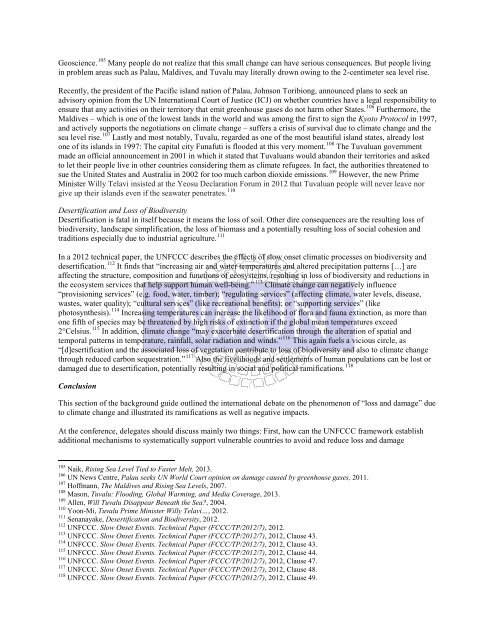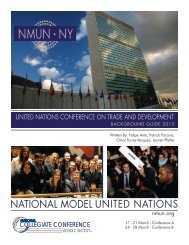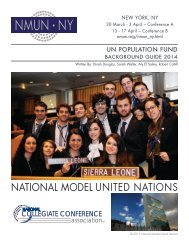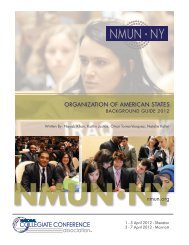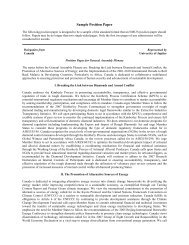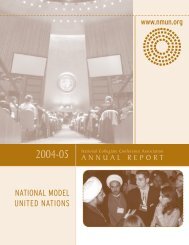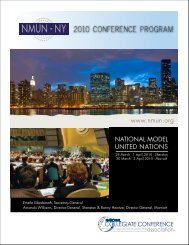NMUN • KOREA - National Model United Nations
NMUN • KOREA - National Model United Nations
NMUN • KOREA - National Model United Nations
Create successful ePaper yourself
Turn your PDF publications into a flip-book with our unique Google optimized e-Paper software.
Geoscience. 105 Many people do not realize that this small change can have serious consequences. But people living<br />
in problem areas such as Palau, Maldives, and Tuvalu may literally drown owing to the 2-centimeter sea level rise.<br />
Recently, the president of the Pacific island nation of Palau, Johnson Toribiong, announced plans to seek an<br />
advisory opinion from the UN International Court of Justice (ICJ) on whether countries have a legal responsibility to<br />
ensure that any activities on their territory that emit greenhouse gases do not harm other States. 106 Furthermore, the<br />
Maldives – which is one of the lowest lands in the world and was among the first to sign the Kyoto Protocol in 1997,<br />
and actively supports the negotiations on climate change – suffers a crisis of survival due to climate change and the<br />
sea level rise. 107 Lastly and most notably, Tuvalu, regarded as one of the most beautiful island states, already lost<br />
one of its islands in 1997: The capital city Funafuti is flooded at this very moment. 108 The Tuvaluan government<br />
made an official announcement in 2001 in which it stated that Tuvaluans would abandon their territories and asked<br />
to let their people live in other countries considering them as climate refugees. In fact, the authorities threatened to<br />
sue the <strong>United</strong> States and Australia in 2002 for too much carbon dioxide emissions. 109 However, the new Prime<br />
Minister Willy Telavi insisted at the Yeosu Declaration Forum in 2012 that Tuvaluan people will never leave nor<br />
give up their islands even if the seawater penetrates. 110<br />
Desertification and Loss of Biodiversity<br />
Desertification is fatal in itself because it means the loss of soil. Other dire consequences are the resulting loss of<br />
biodiversity, landscape simplification, the loss of biomass and a potentially resulting loss of social cohesion and<br />
traditions especially due to industrial agriculture. 111<br />
In a 2012 technical paper, the UNFCCC describes the effects of slow onset climatic processes on biodiversity and<br />
desertification. 112 It finds that “increasing air and water temperatures and altered precipitation patterns […] are<br />
affecting the structure, composition and functions of ecosystems, resulting in loss of biodiversity and reductions in<br />
the ecosystem services that help support human well-being.” 113 Climate change can negatively influence<br />
“provisioning services” (e.g. food, water, timber); “regulating services” (affecting climate, water levels, disease,<br />
wastes, water quality); “cultural services” (like recreational benefits); or “supporting services” (like<br />
photosynthesis). 114 Increasing temperatures can increase the likelihood of flora and fauna extinction, as more than<br />
one fifth of species may be threatened by high risks of extinction if the global mean temperatures exceed<br />
2°Celsius. 115 In addition, climate change “may exacerbate desertification through the alteration of spatial and<br />
temporal patterns in temperature, rainfall, solar radiation and winds.” 116 This again fuels a vicious circle, as<br />
“[d]esertification and the associated loss of vegetation contribute to loss of biodiversity and also to climate change<br />
through reduced carbon sequestration.” 117 Also the livelihoods and settlements of human populations can be lost or<br />
damaged due to desertification, potentially resulting in social and political ramifications. 118<br />
Conclusion<br />
This section of the background guide outlined the international debate on the phenomenon of “loss and damage” due<br />
to climate change and illustrated its ramifications as well as negative impacts.<br />
At the conference, delegates should discuss mainly two things: First, how can the UNFCCC framework establish<br />
additional mechanisms to systematically support vulnerable countries to avoid and reduce loss and damage<br />
105 Naik, Rising Sea Level Tied to Faster Melt, 2013.<br />
106 UN News Centre, Palau seeks UN World Court opinion on damage caused by greenhouse gases, 2011.<br />
107 Hoffmann, The Maldives and Rising Sea Levels, 2007.<br />
108 Mason, Tuvalu: Flooding, Global Warming, and Media Coverage, 2013.<br />
109 Allen, Will Tuvalu Disappear Beneath the Sea?, 2004.<br />
110 Yoon-Mi, Tuvalu Prime Minister Willy Telavi…, 2012.<br />
111 Senanayake, Desertification and Biodiversity, 2012.<br />
112 UNFCCC. Slow Onset Events. Technical Paper (FCCC/TP/2012/7), 2012.<br />
113 UNFCCC. Slow Onset Events. Technical Paper (FCCC/TP/2012/7), 2012, Clause 43.<br />
114 UNFCCC. Slow Onset Events. Technical Paper (FCCC/TP/2012/7), 2012, Clause 43.<br />
115 UNFCCC. Slow Onset Events. Technical Paper (FCCC/TP/2012/7), 2012, Clause 44.<br />
116 UNFCCC. Slow Onset Events. Technical Paper (FCCC/TP/2012/7), 2012, Clause 47.<br />
117 UNFCCC. Slow Onset Events. Technical Paper (FCCC/TP/2012/7), 2012, Clause 48.<br />
118 UNFCCC. Slow Onset Events. Technical Paper (FCCC/TP/2012/7), 2012, Clause 49.


